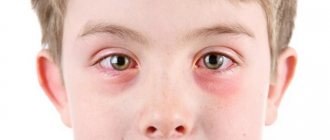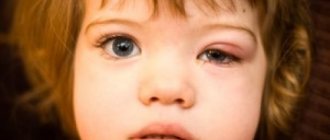What to do if your eye is swollen?
If parents discover that their child has a swollen eye, they need to carefully examine the affected area.
It is necessary to remember what the child was doing the day before (hitting, sitting at the computer a lot), whether there was contact with sharp objects, new cosmetics, insects (for example, if the family is on vacation in exotic countries). You also need to examine your eyes and understand whether the swelling is on only one side or both. If there is a small red dot in the central area of the eyelid, most likely it is an insect bite. Then a visit to the doctor is not required.
Symptoms that require immediate medical consultation
Urgent medical attention is required if:
- swelling of the eyelids is so noticeable that it is difficult for the child to open his eyes;
- the color of the eyelid changes to brown-red and bluish;
- eyes are very watery;
- the child complains of pain, itching, discomfort, sensation of the presence of a foreign object;
- the child has become calmer and refuses usual activities;
- the child constantly scratches and rubs his eyes;
- ARVI symptoms appear;
- the temperature rises;
- upon palpation, inflammatory foci and compactions are detected;
- purulent or other discharge appears from the eyes;
- gastrointestinal disorders are observed (abdominal pain, stool disorders, heaviness, lack of appetite).
You should also consult a doctor if the swelling subsided in the evening, but reappeared in the morning.
Causes
As a rule, the causes of eyelid deformities are congenital hereditary pathologies, diseases of the organs of vision, injuries, a general deterioration in the health of the whole organism, and an unhealthy lifestyle. In this case, the fluid compresses the swollen areas and causes dysfunction of the body.
If swelling occurs due to lifestyle problems, it usually disappears within a day. But diseases and disorders in the body require complex treatment.
Possible diseases
Swelling and redness can occur for various reasons. Some of them require serious intervention and treatment.
Morning swelling of the eyelids
The most harmless swelling of the eyelids is in the morning. It may appear in the background:
- Lack of sleep;
- Late meals;
- Consuming large amounts of salt;
- Drinking a fair amount of fluid (including before bedtime);
- Overwork;
- Smoking;
- Applying cosmetics before bed.
To restore your skin to a healthy appearance and get rid of discomfort, it is enough to normalize your lifestyle and establish proper nutrition and sleep.
Eye diseases
As a rule, swelling of the upper eyelids appears most often in people over forty years of age. But sometimes the reason lies in immediate problems with the organs of vision:
- Inflammation of the eyelids;
- Abscesses;
- Dacryocystitis;
- Meybovit;
- Phlegmon;
- Infectious conjunctivitis;
- Meibomite;
- Hereditary vision diseases (depleted membrane).
Some eye diseases are accompanied not only by swelling, but also by pain, lacrimation, discharge and suppuration.
To treat these diseases, antibiotics (orally and in the form of eye ointment), eye drops, rinsing solutions, anti-inflammatory drugs, and painkillers are usually used.
Diseases of other organs
Swelling of the upper eyelids can appear against the background of the progression and development of pathologies in the body. However, some may be diagnosed in childhood. Among them:
- Kidney diseases;
- Liver diseases;
- Pathologies of the cardiovascular system;
- Problems related to blood and intracranial pressure;
- Skin diseases;
- Infections;
- Bacterial infections.
Treatment of edema of the upper eyelid in this case should be carried out simultaneously with the elimination of the underlying cause.
Other Possible Causes
Even small scratches or touching with your hands can cause deformation and redness. Other reasons include:
Allergic reactions;
- Prolonged cold;
- Injuries to the organs of vision and face;
- Bad habits;
- Stress;
- Poor nutrition;
- Carrying out cosmetic procedures (tattooing);
- Anomaly in the structure of the visual organs;
- A bite of an insect.
To treat this type of edema, it is necessary to normalize the daily routine, take antihistamines, antivirals and diuretics. Lymphatic drainage massage is also successfully used. It is rarely possible to use surgical methods.
Main causes of swelling and redness
Various factors can lead to swelling and redness of a baby's eyelids. Some of them may pose a serious health hazard.
A very common cause of red, puffy eyes in a child is allergies.
A reaction in children can be triggered by food, dust, household chemicals, plants, and pollen.
Often allergies are accompanied by itching of the mucous membranes, runny nose, stuffy nose, and lacrimation.
It is important to notice these manifestations in time and take adequate measures in a timely manner. In severe cases, swelling in the throat may occur
In severe cases, swelling in the throat may occur.
Eyes may also become swollen due to the following factors:
- various infectious lesions;
- injuries, mechanical damage;
- high intracranial pressure;
- serious fluid retention in tissues;
- kidney disorders;
- heart and vascular diseases;
- frequent, prolonged crying;
- sleep disturbances, insomnia, including during teething.
In case of kidney or heart diseases, the baby will experience not only swelling and redness of the eyes. Lacrimation, pain, and irritation are usually absent.
If a red swelling appears in a child in one eye (as in the photo below), on the lower or upper eyelid, then the cause is infection or mechanical damage, which provokes inflammation in the tissues of the eyelid.
Reasons why a child’s lower or upper eyelid is swollen and red:
- Conjunctivitis. The disease is an inflammation of the conjunctiva of an infectious nature, resulting from direct exposure to pathogenic microorganisms. The sclera turns red, profuse discharge of pus and tears occurs. In children it usually occurs in the acute phase. Pus accumulates, envelops the eyelids, making it difficult to open the eyes.
- Barley. This is an acute inflammation of the eyelash bulb. First, a slight swelling of the eyelid is noticed, then the skin turns red, becomes painful, and after 2-3 days severe swelling occurs. A purulent core matures in the bulb, causing increased pain.
- Phlegmon. It may affect the upper or lower eyelid completely (it will become red and swollen). When palpated, the affected area will be very dense, and an elevated temperature is possible. The child experiences severe pain and the eye sclera may turn red. If left untreated, cellulitis can quickly spread to the other eye.
- Insect bites. After a bite and contact with insect venom on the tissues of the eyelid and mucous membrane, noticeable redness, swelling, and lacrimation occur. If you have an allergy, you may additionally experience itching and pain.
- Mechanical damage. It may be the result of sand, dust particles, powder or other particles getting on or under the eyelid. Severe lacrimation, pain, and irritation occur.
The described symptoms usually subside when the swelling of the affected area is reduced. With barley, relief comes when the pus comes to the surface.
Often swollen red eyes (eyelids) accompany additional symptoms. If you take them into account, you can quickly determine the diagnosis and quickly get rid of the problem.
With severe itching and constant scratching of the eye, the cause may be related to insect bites or allergies.
It is important that the baby does not touch the affected area, since active rubbing and scratching may worsen the symptoms and cause injury. Red swelling under the eye in a child, burning, itching - a consequence of irritation of nerve endings and fragile mucous membrane due to a large number of allergens
The body perceives these substances as foreign, and with irritation and lacrimation it will try to remove them
Red swelling under a child's eye, burning, itching is a consequence of irritation of nerve endings and fragile mucous membrane due to a large number of allergens. The body perceives these substances as foreign, and with irritation and lacrimation it will try to remove them.
Redness is observed in almost all of the listed conditions, with the exception of disorders in the functioning of the kidneys and heart.
Redness is also a tissue reaction to a foreign body that injures the eyelid and can cause pain and discomfort.
How to carry out procedures correctly
It is difficult to treat infants, everything is so small and fragile, mothers are often afraid of doing something wrong. Get your act together, your fears can have dire consequences for your child.
Massage is the main method of treating dacryocystitis; at the initial stage it helps to avoid surgical intervention. After cleansing the eyes, swipe your index finger along the sides of the nose to the corner of the eye several times to remove the contents of the nasolacrimal duct. If pus appears, you did everything right.
How to apply eye drops:
- Place a cotton pad on the lower eyelid to avoid accidentally scratching the mucous membrane.
- Gently spread your eyelids apart with your thumb and index finger.
- Place 1-2 drops of the medicine on the lower eyelid, preferably close to the outer or outer edge.
- Close your eye and lightly move your finger from the outer edge of the eye to the inner edge so that the drug is evenly distributed.
Wash your eyes with cotton pads; gauze strands are hard, and pieces of cotton wool can get into the eye. For each eye, use a separate disc, always moving from the outer corner to the inner one.
The best preparation for rinsing for ophthalmological problems is saline solution; it can also be used as a prophylactic agent.
When using ointment, remove the pus with saline or antiseptic, pull the lower eyelid down a little, after applying a cotton pad to it. Squeeze out the required amount of the drug, return the eyelid to its normal position, distribute the medicine with light massage movements, and remove the remaining residue with a cotton pad.
Before any manipulation, do not forget to thoroughly clean your hands with antiseptic agents.
The child's eyes are swollen due to fever and acute respiratory viral infection
Children often have swollen eyes, which immediately causes concern among parents. But before you panic, you need to identify the cause of this process, which will indicate subsequent actions.
Swelling of the face, namely around the eyes, can be either inflammatory or occur for other reasons. Swelling occurs due to an increase in the amount of fluid under the skin. Most often, swelling of the eyelids in children is short-term and painless, but sometimes it can cause prolonged and severe discomfort.
In newborns, swelling may occur due to prolonged crying and screaming. In a baby, the causes of swelling of the eyes may be a violation of their lifestyle or even an incorrect position of their body during sleep.
If the baby's head is lower than the body, then in the morning swelling of the eyelids and cheeks will appear. In newborns, facial swelling may be a hereditary feature.
For example, if relatives had slight swelling in the eye area, then they may also appear in the baby.
Currently, the causes of eye swelling can be such as excessive TV watching, or a child spending a long time in front of a computer monitor, tablet or mobile phone.
Edema of the inflammatory type
The inflammatory nature of eye swelling is characterized by distinct redness of the eyelid, increased temperature, and unpleasant sensations when touched.
The reasons that cause it are:
stye - purulent inflammation of the sebaceous glands of the eyelid; dacryocystitis is a painful process in the lacrimal sac; erysipelas is an infectious inflammatory disease of the eyelid; conjunctivitis - bacteria entering the eye cavity; inflammation of the salivary glands and adjacent lymph nodes; damage to internal organs and muscles by parasites; colds.
In newborns, infection of the salivary glands occurs in the womb, so babies are born with swelling of the face and severe damage to internal organs.
Consequence of internal diseases
Non-inflammatory swelling often affects both eyes and appears in the morning. The reasons for this type of swelling are:
diseases that cause increased pressure inside the skull; various pathologies of the kidneys, liver, lungs; congenital diseases of the cardiovascular system; inherited cysts and tumors; poor nutrition and metabolism; lack of vitamins and minerals; hemoglobin is below normal; violation of venous circulation in the eye area; anatomical feature of the structure of the eye or eyelid; violation of lymph outflow.
Very rarely, but swelling of the eyes is caused by urolithiasis. In a baby, swelling may be due to a lack of thyroid hormones, which will manifest itself in the first months of life. In children, enlargement of the pharyngeal tonsil occurs, which makes breathing difficult and disrupts many processes in the body.
Traumatic swelling of the face
Traumatic swelling of the face and surrounding structures of the eye in children may occur due to:
damage to the eyelid or the skin around it; insect bite; strong exposure to the sun on the baby’s delicate skin; prolonged bathing or getting dirty water into the eyes; incorrect or very long wearing of eye lenses.
The presence of lice on the roots of the eyelashes also causes swelling, but of the upper eyelid.
Allergic type
Allergic swelling under the eye in a child is in most cases painless, but may cause a desire to scratch the site of occurrence.
This process can also spread to the face, namely the cheek up to the corner of the mouth. The causes of such swelling are allergens, most often from food or medications, especially topical use.
With this type of swelling, the upper eyelid of one eye most often suffers.
Very often, swelling of the eyelid is accompanied by the same process on the face, but the latter can also be caused by independent factors:
onset of diabetes mellitus (in older children); mumps behind the ears (parotitis), up to swelling of the neck; purulent inflammatory processes of teeth and gums; sinus diseases.
As you can see, with the help of swelling under a child’s eye, we can testify to many processes occurring in his body. In a baby, this may indicate very dangerous diseases or various pathologies. But before treatment, you need to go to the doctor and understand why the child’s eyes are swollen.
Barley
Barley appears on the eyelid due to the onset of an inflammatory process. The cause of this is most often a bacterial infection, in particular Staphylococcus aureus. The following factors can provoke activation of the inflammatory process:
- hypothermia;
- weakened immune system;
- chronic diseases;
- bad ecology;
- overwork;
- monotonous food;
- taking medications.
The child develops swelling, itching, and burning in the eye area. This also affects the general condition, the baby becomes capricious and refuses to eat. Severe redness of the eyelid also extends to the conjunctiva.
The swelling is local at first and then spreads throughout the eye. Around the fifth day, the barley opens. Sometimes the abscess resolves on its own, but this is the exception rather than the rule.
Internal stye must be monitored especially carefully, as it can rupture into the conjunctiva and cause a general infection of the orbit.
Treatment of eye inflammation includes the use of eye drops:
- Oftalmoferon. It is even approved for use by newborn children;
- Albucid helps cure barley in the shortest possible time. The drops are very hot, so the baby will resist such treatment in every possible way;
- Tobrex does not sting the child’s eyes, but at the same time has pronounced antibacterial properties.
Eye ointments are also used, which are placed under the lower eyelid. This dosage form does not cause irritation to the mucous membrane. Doctors usually prescribe erythromycin and tetracycline ointments.
Populists advise using herbs that have anti-inflammatory activity: plantain, chamomile, string, calendula. As dry heat, you can use a warm egg or a bag of salt heated in a frying pan.
Aloe juice also helps stop the inflammatory reaction. It must be diluted in equal proportions with water. Soak a small piece of cotton wool in the resulting solution and apply to the affected area.
Stye is a common cause of eye inflammation in children.
How does swelling occur?
Swelling and tumors of the eyes occur in every person and can be a normal variant. For example, after sleep, everyone (both adults and children) has slightly swollen eyelids. They are more plump, dense, and barely itch (which is why the habit of rubbing them appears). Small crusts can sometimes form in the corners of the eyes.
Such symptoms can appear in anyone after sleep. The fact is that when a person lies down, lymph circulates throughout the body a little differently, which is why such stagnation occurs. Normally, swelling is barely visible, it does not interfere, does not cause discomfort and goes away quickly.
If a child has swelling of the eyes, and this does not go away over time, it itches or hurts, becomes inflamed, this is a pathology, and an adult must react correctly to its occurrence.
Note! As a rule, it is not the eye itself that swells, but the eyelids surrounding it. Inflammation and redness may spread throughout the eyeball, but swelling of the sclera is rarely observed
Only a qualified specialist can diagnose it.
Diagnostics
Determining the cause of the inflammatory process is carried out in several stages:
- Questioning the patient or parents. They will talk about disturbing symptoms, the presence of inflammation, redness, increased lacrimation;
- General inspection. It can be performed using a slit lamp. The doctor determines tissue swelling and redness.
- Bacteriological culture. It is carried out if an infectious infection is suspected. The laboratory technician determines the exact type of bacteria and the antibiotic to which it is sensitive.
- PCR. Using the method, the virus that causes the disease is determined.
- Allergy test. It is held in autumn or winter. Various types of allergens are applied to the patient's wrist. If redness, inflammation, or swelling is detected in any area of the skin, this indicates that the person has an allergy.
- Fundus examination. To do this, Atropine and similar drugs are instilled into the patient's eyes. The ophthalmologist evaluates the structural elements of the eyes, especially the retinal area.
- Assessment of visual acuity. It is carried out if there is a suspicion that the inflammatory process has affected the patient’s visual function. Diagnostic tables are used; the more lines a person sees, the better his vision.
After all the diagnostic tests have been performed, the doctor makes a reliable diagnosis, and only then does treatment begin.
When should you take your child to the doctor?
You should not postpone a visit to a specialist if swelling in the eyelid area is accompanied by the following symptoms:
- Red tint of the mucous membranes of the organs of vision.
- Copious flow of tear fluid, mucus from the nose.
- Restlessness or lethargy.
- Swelling of the fontanel, bouts of crying in infants (these symptoms often indicate increased pressure inside the skull).
- Disturbance in the process of urine excretion.
- Discomfort in the lumbar region.
- Temperature increase.
Headache.
In addition, you should consult a doctor if your child experiences swelling of the eyes after sleep for several days. The cause of the symptom can be determined after examination.
Prevention of eyelid diseases
Redness and swelling of the eyelids is a sign of inflammatory eye disease. The problem can be avoided by taking preventive measures. Infancy or one-year-old children deserve special attention. During this period, prevention of eye diseases is carried out daily. It includes a number of rules.
- Child hygiene. Washing is carried out daily with clean water. For infants, warm boiled water is used. The child’s hands are washed with soap after each walk. Newborns are the most demanding about personal hygiene.
- Personal hygiene. Before carrying out procedures with a child, you must wash your hands with soap or an antibacterial agent.
- Minimal eye contact. The child should not touch his eyes with his hands, especially while walking.
- Walks. Children need fresh air. It is recommended to walk for several hours every day. Dr. Komarovsky advises taking children for a walk in any weather.
- Visiting public places. During the period of colds, it is recommended to avoid public places with children.
- Well-being control. The behavior and mood of a small child must be closely monitored. A sharp change in mood indicates the onset of the disease.
- Competent treatment. Colds and viral diseases in children require competent and complete treatment under the supervision of a pediatrician.
- Contact with animals. Pet hair can trigger an allergic response in the mucous membranes of the eyes. If there is no confidence in the health of pets, it is recommended that young children limit contact with animals.
Compliance with hygiene rules is the key to a child’s eye health.
Compliance with the rules of prevention can significantly reduce the risk of developing inflammatory processes in the mucous membranes of the eyes and eyelids.
Sep 26, 2017Anastasia Tabalina
Children are the most precious thing in the life of every parent. Any trouble can throw you out of your usual rut. Especially if it is related to the baby’s health.
Have you noticed that your baby is feeling uncomfortable? Does your child have a swollen upper eyelid? This is a serious reason to sound the alarm and consult a doctor.
Preventive measures
To avoid any infection getting into the visual organs, you must follow certain rules, namely:
- You should try not to touch your eyes with dirty hands - before using contact lenses, removing makeup and other procedures, you must wash your palms.
- You cannot use other people's handkerchiefs, eye shadows or creams.
- It is not recommended to rub your eyes with the inner surface of your fingers.
- It is prohibited to use expired or low-quality cosmetics.
- Be sure to use goggles for protection when carrying out construction work.
In addition, it is necessary to use vitamin complexes, proper nutrition and regular walks in the fresh air to boost immunity, and also monitor the condition of internal organs, as this also prevents the development of eye inflammation.
It is known that infection enters the eyes in different ways, and to prevent this, preventive measures should not be neglected. If, however, inflammation cannot be avoided, a mandatory visit to a specialist is required, since self-medication can lead to disastrous consequences.
Experienced specialists in the video talk about the common disease conjunctivitis:
Therapy methods
Methods to combat this phenomenon are determined by the nature of the pathology that provoked its occurrence. In some cases, you can do without the use of medications. However, if the doctor recommends the use of drugs, they should be taken according to the schedule. How to remove swelling of the eyes after sleep and improve the appearance of your face? There are several ways to combat swelling, for example:
- Apply compresses with cool water to the visual area. The lotions should be applied within five minutes. This procedure is carried out several times a day.
- There are cases when the swelling is associated with pediculosis. Lice live not only in hair. To reduce swelling, you should lubricate the eyelid area in the area where eyelashes grow with a small amount of Vaseline.
- If there is a pathology of the urinary system, it is necessary to use the medications prescribed by the doctor. Typically, such patients are recommended drugs with anti-inflammatory effects and drugs that help destroy bacteria.
- Before going outside in sunny weather, you need to apply a little protective cream to the surface of your vision.
- If an allergic reaction occurs, the little patient is prescribed medications with antihistamine action. It is also necessary to adhere to a special diet.
- When the pressure inside the skull increases, a child’s eyes are often swollen after sleep. The cause of this nature can be eliminated by using medications with a sedative effect.
Treatment
It is possible to cope with the inflammatory process in the eyes using various methods and means that should be selected by a specialist. The choice of treatment method depends on the nature of the pathology and the cause that provoked the appearance of unpleasant symptoms. Only a specialist can determine how to treat inflammation of the lower eyelid.
Folk remedies
Along with drug therapy at home, you can use traditional medicine recipes. A good effect is achieved by using decoctions and lotions of medicinal herbs, which you can prepare yourself.
It is possible to stop the inflammatory process in the eye using the following alternative medicine recipes:
- Chamomile decoction. To prepare the medicine, you need to pour a tablespoon of dry raw materials into a bowl and brew a glass of boiling water. The prepared product should be used warm to wash the affected eye membranes and eyelids. It is recommended to carry out this procedure several times during the day until the unpleasant symptoms are completely eliminated.
- Clover juice. Clover juice has a good effect in the fight against inflammatory diseases of the organs of vision. To prepare the solution, you need to take a handful of flowers and squeeze the juice out of them using gauze. This remedy must be used to treat the inflamed eyelid throughout the day.
- Cumin seeds. It is possible to quickly cope with the inflammatory process in the eyes and alleviate the patient’s condition with the help of a remedy made from caraway seeds. To prepare it, brew a teaspoon of raw material with 200 ml of boiling water and leave to steep for an hour. After a while, the product should be filtered through gauze, moistened with a cotton pad and applied to the inflamed eye. It is recommended to carry out this procedure several times during the day.
A simple and proven remedy is to brew black tea, which is best used without impurities, additives and sugar. The prepared tea must be fresh, because after 5 hours it forms toxic substances that are harmful to the body. It is necessary to moisten a gauze bandage in the tea leaves and apply it to the inflamed eyelid for 10 minutes. It is best to do this procedure several times a day until the unpleasant symptoms are completely eliminated.
Eye drops and ointments
For inflammation of the lower eyelid, drug treatment consists of daily washing and treating the affected organ of vision with solutions with an antiseptic effect and a suspension that slightly dries the inflamed area.
The patient’s condition can be alleviated using the following medications:
- Alomide;
- Lecrolin;
- Hydrocortisone;
- Maxitrol;
- Dexamethasone.
If the cause of the inflammatory process is demodicosis, then medications are selected that have a detrimental effect on mites. Basically, medications are selected in the form of an ointment, which should be applied to the affected area before going to bed. The medication contains components that disrupt the normal functioning of ticks and shorten their natural cycle.
With the allergic nature of the inflammatory process, the main goal of treatment is to eliminate the allergen that caused the disease. If this is not possible, corticosteroid ointments and anti-allergic drugs are selected. To eliminate the pathological irritant, the use of antibacterial drugs and anti-inflammatory drugs is indicated. A good effect in the treatment of eye pathologies is achieved by antiseptic treatment, which is carried out with a soft sterile swab. Typically, this procedure is resorted to if purulent exudate accumulates under the eyelid and papules form.
In addition to drug treatment, physiotherapeutic procedures are prescribed. It is possible to eliminate the inflammatory process with the help of electrical stimulation and antiseptic applications. The choice of one or another physiotherapy procedure depends on the general condition of the patient, age and the reasons that caused the disease.
Prevention of eyelid swelling
To prevent swelling of the eyelids, you should lead a healthy lifestyle, stop smoking and alcoholic beverages, and do not overuse salty, spicy and pickled foods, especially at night. Women should be careful when choosing decorative cosmetics and be sure to wash off makeup before going to bed
In addition, it is important to protect the eyes from the negative effects of external factors (ultraviolet radiation, mechanical damage), treat infectious diseases in a timely manner, monitor the functioning of the kidneys and cardiovascular system
Prevention of eyelid swelling
Swelling of the upper eyelid of one eye can be a common cosmetic problem, but in some cases it indicates the development of serious diseases, so you should consult your doctor if this symptom appears.
Video - Ptosis of the upper eyelid
https://youtube.com/watch?v=okSoNGtr0QM
Do you know that:
Regular use of a solarium increases your chance of developing skin cancer by 60%.
A job that a person doesn’t like is much more harmful to his psyche than no job at all.
The human stomach copes well with foreign objects without medical intervention. It is known that gastric juice can even dissolve coins.
According to WHO research, talking on a mobile phone for half an hour every day increases the likelihood of developing a brain tumor by 40%.
74-year-old Australian resident James Harrison has donated blood about 1,000 times. He has a rare blood type whose antibodies help newborns with severe anemia survive. Thus, the Australian saved about two million children.
In an effort to get the patient out, doctors often go too far. For example, a certain Charles Jensen in the period from 1954 to 1994. survived more than 900 operations to remove tumors.
Human bones are four times stronger than concrete.
The average life expectancy of left-handers is shorter than that of right-handers.
American scientists conducted experiments on mice and came to the conclusion that watermelon juice prevents the development of vascular atherosclerosis. One group of mice drank plain water, and the second group drank watermelon juice. As a result, the vessels of the second group were free of cholesterol plaques.
People who eat breakfast regularly are much less likely to be obese.
An educated person is less susceptible to brain diseases. Intellectual activity promotes the formation of additional tissue that compensates for the disease.
Even if a person's heart does not beat, he can still live for a long period of time, as the Norwegian fisherman Jan Revsdal demonstrated to us. His “engine” stopped for 4 hours after a fisherman got lost and fell asleep in the snow.
During operation, our brain expends an amount of energy equal to a 10-watt light bulb. So the image of a light bulb above your head at the moment an interesting thought arises is not so far from the truth.
According to statistics, on Mondays the risk of back injuries increases by 25%, and the risk of a heart attack by 33%. Be careful.
The well-known drug Viagra was originally developed for the treatment of arterial hypertension.
ratings, average:
out of 5)
Swelling, redness and swelling of the eyelids in children occurs at different ages. Children of preschool age are most susceptible to the disease. Swelling of the eyelids and redness of the mucous membrane is associated with the development of the inflammatory process. The occurrence of unpleasant symptoms is provoked by conjunctivitis, caused by infection or foreign particles entering the mucous membrane of the eye.
What to do
In most cases, an examination by a doctor is required. But parents cannot sit and do nothing while their child suffers. We will describe first aid for various causes of swelling.
What to do if the reason is not found
Some children develop lumps and lumps on their lids, which can impair the development of good vision. In particular, a blood vessel tumor called a capillary or strawberry hemangioma can start as a small tumor and grow quickly. They will increase during the first year of life and then begin to resolve spontaneously over the next few years of life. If they become large enough, they may prevent your child from developing good vision in the affected eye and will need to be treated.
For bites
Insect bites, in addition to swelling, can cause increased blood pressure, heart rhythm disturbances and even suffocation. If the child is allergic, it is necessary to take an antihistamine. A special gel (“Fenistil”, “Psilo-balm”) can be applied to the site of swelling to relieve itching, swelling and redness.
Because of their ability to cause vision problems, any child who begins to show any lumps or bumps around either eye should be examined by an ophthalmologist. The baby may also be born with a flat, purple-colored lesion on the face called a port wine stain, due to its resemblance to dark red wine. If this birthmark is associated with the eye, especially the operculum, the child may be at risk of developing glaucoma or amblyopia. Any baby born with this birthmark should be examined by an ophthalmologist soon after birth.
There are a lot of folk methods. We list the safe and effective ones.
- Apply half a cut potato to the area of swelling on your face.
- A compress of parsley, mint or bird cherry leaves will also help to quickly relieve swelling.
If a foreign body enters
Is your eye red, swollen and watery? First of all, try to provide first aid at home, before visiting a doctor. If the foreign body is large and deep, then under no circumstances try to pull it out yourself.
What is contraindicated for redness of the eyelids?
Small dark moles, called nevi, on the eyelids or the white part of the eye rarely cause any problems or need to be removed. Once they are assessed by your pediatrician, these signs should only be cause for concern if they change in size, shape, or color.
Causes of symptoms
Small, hard, flesh-colored bumps on your child's eyelids or under the eyebrows are usually dermoid cysts. These are non-cancerous tumors that are usually present from birth. Dermoids will not become cancerous unless removed; however, since they tend to enlarge during puberty, their removal during the preschool years is preferred in most cases.
Doctors recommend the following procedure:
- Make sure your child does not rub his eye.
- Keep your eye closed. Blinking will cause more severe injury.
- Apply an eye patch and see a doctor.
If the irritant is a small speck, you can try to get rid of it yourself.
A chalazia is a cyst caused by a blockage of the omental gland. Stir, or ordeol, is a bacterial infection of the cells surrounding the sweat glands or hair follicles at the edge of the operculum. Call your pediatrician about treatment for these conditions. He will probably tell you to apply warm compresses directly to your eyelid for twenty or thirty minutes three or four times a day until the chalazine or wash clears.
Causes of red eyelids in a newborn
The doctor may want to evaluate your child before prescribing additional treatment, such as antibiotic ointment or drops. Once your child has had stylae or halacia, she may be more likely to get them again. When chalagia occurs repeatedly, it is sometimes necessary to perform liquid scrubs to reduce bacterial colonization of the eyelids and open the oil gland pores.
- Sequentially move back the lower and upper eyelids and inspect the tissue underneath. Locate the foreign body.
- Try to remove the visible foreign object with a clean cotton swab or a corner of a cotton handkerchief.
- Rinse your eye with clean, cool water. This will relieve discomfort.
- If after removal a pain appears and it does not go away, put moisturizing drops into the baby’s eye.
After all the procedures, the eye may begin to fester. This means that an infection has entered the eye and conjunctivitis has begun to develop.
First aid for eye diseases
If you notice that your child’s eye is inflamed, then under no circumstances self-medicate. You should see an ophthalmologist immediately
It is important not to waste time and correctly diagnose and prescribe appropriate treatment. Delay in dealing with certain diseases can affect the child’s vision in the future, so do not allow this to happen.
All you can do is rid the eye of purulent discharge, which causes discomfort to the baby. The procedure is carried out only with sterile swabs and boiled water. You can dissolve a furatsilin tablet in a glass of liquid and treat the eyes with the resulting solution. Despite the fact that one eye can become inflamed, both are required to be treated. Do not use any drops yourself before visiting a doctor.
Treatment of eye diseases occurs by instilling drops. They all contain an antibiotic. The doctor will determine which type your child needs. Sometimes a specialist may allow you to use additional folk remedies. These include compresses and rinses. The first ones help to cope with irritation of the skin around the eyes and soothe it. Herbal decoctions are used for this purpose. Washing also has its advantages. They relieve the mucous membrane of the eye from bad secretions and relieve irritation. Wash the eyes with a solution of pharmaceutical chamomile, which is infused for about an hour. Remember, never use breast milk or saliva for rinsing. Since they contain a favorable environment for the proliferation of infection.
Other reasons
To understand why the eyelids of newborns swell, it is necessary to find out whether the baby’s tear-nasal canal is inflamed.
Also, the cause of swelling of the eyelids and eyes in a newborn baby may be the postpartum outflow of fluids. An older child may suffer from itchy and swollen eyes for the following reasons:
Itchy eyes
- Foreign body. While playing, a small child may insert an object under the eyelid, which will cause swelling and redness of the eyes and eyelids.
- Infectious or bacterial conjunctivitis. An infection on the outer layer of the eyeball causes inflammation of the conjunctival membrane.
- Blepharitis. A condition characterized by inflammation of the eyes, peeling and swelling of the eyelids in the morning.
- Chalazion. If a small lump has formed on the eyelid that itches, hurts and turns red, there is a blockage of the meibomian gland. The reasons for the formation of chalazion are violation of hygiene rules and hormonal imbalances.
- Insect bites. Insect bites are the most common causes of swelling and redness of the upper and lower eyelids.
- Barley. The inflammatory process in the eyelash bulbs provokes swelling of the eyelids. The place where the barley forms is itchy and painful….
Related and recommended questions
Conjunctivitis of the eye in a child Doctor. Help the child, please. My daughter is 4 months old and...
Pus is flowing from the baby's eye. The baby is 3 weeks old, a tear is flowing from the eye and pus...
The eye is inflamed, how to treat it. A five-month-old girl’s eye is inflamed, it has been…
Inflammation of the eyes Consultation is very necessary. A month ago my eyes became inflamed, redness,...
Inflammation The child is 8 months old. We have stage 5 retinopathy of prematurity. At 3 months...
Inflammation of the eye during chickenpox in a child. My name is Evgenia, my son…
The child rubs his eyes and screams in pain. My daughter (1 year and 10 months) had more than a month ago...
A child's eye is swollen. A 1-year-old child has an inflamed eye, the membrane is red and cloudy and...
One eye is festering. The child’s right eye is festering, what can I drip and what can I use to wash it with?...
The whites of the child's eyes are red The whites of the child's eyes are red. He is 3 years old. In the morning...
Inflammation of the eyes, eye drops My eyes began to become inflamed, red, a feeling...
Baby's eyes are festering Dear Doctor! I would like to ask you the following question:...
Cold eyes After I had a cold, my eyes began to see poorly, there was no sharpness...
My little girl’s eye (on the 1st) suffered from a cold, and after that her eye festered...
The child poked his finger in the eye, after which it turned red and hurt (whining quietly), did not water,...
The child’s eyes are red Dear doctor, please tell me what could be wrong...
The child’s pupil is dilated. Tell me what to do if the child has a cold or has snot. Appeared...
Eye is watering Please help us, we don’t know what to do!! The child was 3 months old...
The child poked his finger into his eye. The child poked his finger into his eye. Immediately there was a feeling...
The child’s eyes are festering. The baby is 8 months old, our eyes are festering, possibilities...
Prevention
It is almost impossible to avoid swelling of the eyelids, but you can follow simple rules to generally maintain the body’s protective functions, which will also affect eye health
So, it is important that the child follows a sleep schedule and gives rest to his eyes during prolonged stress.
It is necessary to monitor the baby’s nutrition and physical activity. All this will help maintain health and increase resistance to viruses and bacteria.
Maintaining basic hygiene, washing your hands and understanding that you do not need to rub your eyes will help avoid infection and mechanical damage to tissues.
Additional information on the topic of the article is in the video with Dr. Komarovsky.









